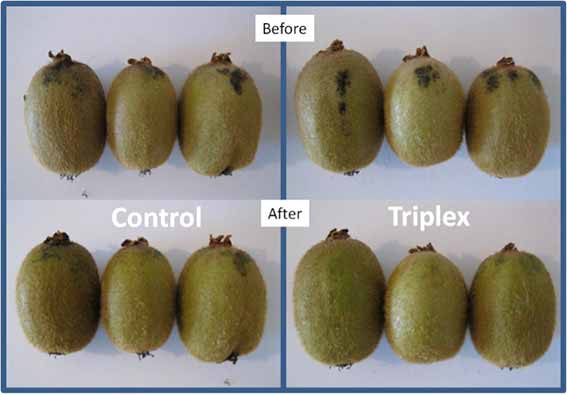TripleX Case Study
Biostart TripleX control of Sooty Mould
An overview of trial work
Dr Jerome Demmer, R & D Director, Biostart Ltd
5th March 2014
Overview
The following is a summary of experiments carried out by Biocult, an independent testing company, on behalf of BioStart, measuring the activity of Triplex in controlling the growth of sooty mould isolated from kiwifruit.
Results


In vitro Biological Assays of TripleX
To establish whether TripleX has preventative activity against Sooty Mould a number ofin vitro laboratory studies were conducted.
Zone of Inhibition Study – Bs1b Microbe
In this trial, bacterial cultures of the active ingredient of TripleX,Bacillus amyloliquefaciens or Bs1b, was added to agar dishes that had been inoculated with sooty mould spores. The sooty mould used in these trials had been isolated from kiwifruit. The Bs1b bacteria completely inhibited the growth and development of the sooty mould spores thereby showing that B. amyloliquefaciens BS1b has a very strong activity against sooty mould.
Zone of Inhibition Study – TripleX Product
In this trial, TripleX, either neat or diluted 1:200, was added to agar dishes that had been inoculated with sooty mould spores at either a high or low dose. The sooty mould used in these trials had been isolated from kiwifruit. The test of TripleX 1:200 allows the Bs1b microbe to be evaluated over the background activity of the other ingredients in the TripleX formulation.
Both the neat and diluted TripleX had activity against sooty mould with the activity in the diluted TripleX being due to Bs1b. The Bs1b activity took time to develop as the microbe grew and was directly correlated by the number of microbes present.
These tests were conducted at both low and high spore dose rates of sooty mould.
High Sooty Mould Spore Levels
| ZOI (mm) | Day 2 | Day 3 | Day 5 |
| Triplex – neat | 0.80 | 0.50 | 0.30 |
| Triplex – 1:200 | 0.45 | 0.30 | 0.40 |
| Control | 0.00 | 0.00 | 0.00 |
Low Sooty Mould Spore Levels
/table>
| ZOI (mm) | Day 2 | Day 3 | Day 5 |
| Triplex – neat | 0.90 | 0.70 | 0.30 |
| Triplex – 1:200 | 0.45 | 0.50 | 0.60 |
| Control | 0.00 | 0.00 | 0.00 |
Sooty Mould Spore Germination Inhibition Study
In this trial, TripleX was tested for its ability to inhibit spore germination and the subsequent mycelial growth of sooty mould. The sooty mould used in these trials had been isolated from kiwifruit.
| Microscopy % spore germination Day 1 | Visual % Mycelium growth Day 2 | Visual % Mycelium growth Day 4 | |
| Triplex – 1:200 | 8 | 50 (Slight BS-1b growth) | 25 (Good BS-1b growth |
| Untreated Control | 100 | 100 | 100 |
TripleX was tested at a range of concentrations (1:50, 1:100 and 1:200) and all rates provided good reduction in spore germination when compared to controls. The reduction for 1:200 dilution was best at 92 % reduction in spore germination.
Observations of mycelium growth on days 2 and 4 showed that Triplex at 1:200 reduced mycelium growth by 50 and 75 %, respectively. This demonstrated that as Bs1b grew and became established it was able to exert its biocontrol activity on the sooty mould.

Sooty Mould Infected Fruit Study
Kiwifruit with clear symptoms of sooty mould infection were dipped in a diluted TripleX solution (1:200). After 2 minutes in the solution the fruit were gently rubbed and assessed for the remaining sooty mould infection. These trials showed that washing fruit in TripleX allowed the sooty mould to be easily removed from the fruit. The sooty mould could not be easily removed from the fruit dipped in water.
Summary
- Biostart TripleX and its active ingredient, B. amyloliquefaciens BS-1b, showed good sooty mould inhibition in a range of in vitro test systems.
- TripleX is currently undergoing a range of field trials in commercial kiwifruit orchards.
- TripleX is commercially available and on the Zespri ‘Approved but Unproven” list.
Ready to get started?
Check out the TripleX product page:

